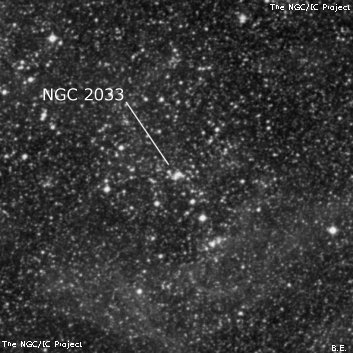
Adding an NPB filter brings out the associated nebulosity (LHA 120-N54), which is fairly bright and very large. A curving swath of nebulosity, elongated E-W for ~8' is on the southwest side of the association. The cluster itself is also encased in diffuse nebulosity with the filter. NGC 2037 is generally taken as a small knot (BCDSP 8) within this star cloud. NGC 2048, a bright emission nebula, is at the NE end of the association and together with NGC 2033 form part of a Superbubble.
John Herschel discovered NGC 2033 between Nov 1836 and Mar 1837 with a 5-inch refractor and recorded it as #579 in his preliminary catalogue of "Stars, Nebulae and Clusters in the Nubecula Major." Herschel's position falls in the large stellar association LH 81. But as there is no listing or description in the CGH catalogue, it's possible Herschel was recording a small knot or a very large field of stars + nebulosity. So, the size and center is unknown. See NGC 2037 for more. The large nebulosity on the south side of the association might be NGC 2052. See that number.
James Dunlop possibly discovered NGC 2033 = D 141? earlier on 24 Sep 1826, recording "a faint extended nebula, about 4' long, very faint towards the extremities, brightest and broadest in the middle. This is in the south following side of a faint cluster of very minute stars." Dunlop's position (single observation) is 11' SE of this nebulous cluster.
300/350mm - 14" (4/4/16 - Coonabarabran, 145x and 230x): large bright star cloud (stellar association LH 81), ~10' diameter with ~50 stars (depending on size taken) mag 11-14.
Notes by Steve Gottlieb